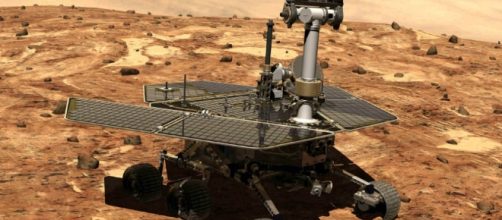NASA´s Mars exploration rovers (MER) involves two rovers -- Spirit and Opportunity. They were launched on June 10 and July 17, 2003, respectively and reached the Martian surface on January 4 and January 25, 2004, a little over six months after their launch. Their primary mission was to search, analyze, and distinguish varied rocks and soils that relate to the water activity on the Mars surface in the past.
Landing sites
Each of these spacecraft were directed to regions on opposite regions on Mars that are thought to have had water activity in the past.
Spirit landed on a site known as Gusev Crater, where rocks, containing pyroxene, olivine, plagioclase, and magnetite minerals were found. Opportunity was targeted to Meridian Planum, another area where minerals, including hematite, indicate the existence of water on Mars.
Science instruments
Being twin spacecraft, both Spirit and Opportunitycarry the same instruments. A panoramic camera (Pancam) that allows to capture in images the local territory. Miniature Thermal Emission Spectrometer (Mini-TES) to take weather reports and to identify rocks and soils. Mossbauer Spectrometer (MB) to study the mineral contents of iron bearing rocks and soils.
Alpha Particle X-ray Spectrometer (APXS) for closer examination of the elements within rocks and soils.
Magnets for the collection of magnetized dust particles. Microscopic imager (MI) for getting clear and higher resolution images of samples. Rock Abrasion Tool (RAT) for removing dust and other debris from rock samples so they can be appropriately studied.
Both of these rovers have the functionality of a geologist doing research on earth. The mast-mounted cameras have a stereoscopic field capacity of 360 degrees, which allows to view the terrain in every direction. The robotic arm can mimic the movement of an arm, with an elbow that bends and a wrist that twist; the mechanical fist has a microscopic camera, having the functionality of a magnifying lens and the rock abrasion tool functions as a hammer that can break rocks, allowing to see what´s inside.
Built design that lasts long
The rovers´ mobility systems were designed with aluminum and titanium to allow them to withstand the tough terrain and temperatures of up to 100 C° (180 F°). Each rover is equipped with a sis wheel drive and a rocker bogie designed for stability, which allows then to tilt up to 45° without turning over. A special kind of shaft that allows to spread the weight across the six wheels.
Eight radioisotope heaters made of plutonium oxide to maintain the cold sensitive instruments at optimum working temperature. They possess the ability to lean towards the direction of the sun to get the most light for their power, allowing their wing-shaped solar panels to capture more sunlight.Occasionally, whirling columns of dust known as dust devils have removed the accumulated dust on their solar panels, permitting to continue obtain sunlight for power.

